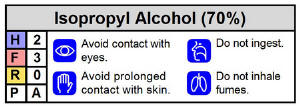Labels on Hazardous Materials Containers
We’ve use the colored bars and numbers style of hazard materials label for years, but I’m hearing that we must now change them. Is this true?
The short answer is no, practices can continue to use whatever style of label best suits their operation.
OSHA’s Hazard Communication Standard (HCS) is the regulation covering chemicals which are used in the workplace. Under the definitions of that rule, when a chemical product is shipped, the label that is attached to the container is known as the MANUFACTURER’S label. That label displays, among other things, the name of the product and any appropriate warnings. As long as the original label remains intact and readable, there is no need for any additional action on the part of the veterinary practice. If the manufacturer's label becomes unreadable or if the product is transferred to other containers for dilution, storage or use, then the practice must add a label to those "secondary containers." That label is known as the SECONDARY CONTAINER label or the WORKPLACE label.
A few years ago, OSHA revised the HCS and adopted the initiative known as the Globally Harmonized System (GHS). One part of the GHS program that has received a lot of attention recently is the changes to the labeling rules. In the initial information presented by OSHA it appeared that all labels for chemical products would be required to adopt the very stringent GHS pictograms, product identifier, signal word, hazard statements and precautionary phrases. OSHA quickly clarified that part of the regulation to emphasized the GHS label rules apply only to MANUFACTURER’S product and shipping labels. OSHA has not changed the WORKPLACE or secondary container label rules. (www.osha.gov/Publications /OSHA3636.pdf) Employers such as veterinary practices are still free to use secondary container labels in any style or size as long as they convey the appropriate information and do not conflict or confuse the GHS pictograms or signal words.
So what do the workplace labels need to look like and include?
There is a lot of flexibility intentionally built into the labeling
requirements and the practice owner or manager has the right to
choose exactly what their secondary or workplace labels look like.
No matter what the chemical product or style of the container, the
two pieces of information that must be present on secondary
container labels are (1) the identification of the chemical, and (2)
all appropriate warnings.
Secondary container labels such as those sold by SafetyVet based on the Hazard Materials Information System (HMIS) are designed to provide written and visual information to the reader about the product and its hazards. The HMIS style of label has been successfully used in workplaces world-wide for over 30 years and is still recognized as an effective method of communicating product hazards to workers.
Of course, the labels must be complete in order to be effective. We routinely see practices that obtain pre-designed labels such as the HMIS type and apply them to bottles without actually completing all of the information required. Remember, the required information is 1) what’s in the bottle AND 2) What hazards or warnings should the user know. So in order for any label to meet the requirements, it has to be complete.
If workplace labels simply use printed words to convey the hazards or warnings, the reader will get all of the required knowledge simply from the words on the label. However, if the label uses pictures, symbols or ratings, such as those based on the HMIS, employees must be trained on the meaning of the symbols, colors or ratings on the labels. The easiest way to achieve that training is to display a “key” or poster explaining the system such as this one.
Getting them to stick!
Here's some tips for making labels stick better and last longer:
- Wash & dry the outside of the bottle before applying the label to remove oil or dirt that will interfere with the adhesive.
- If the container is likely to see heavy use, place clear acetate tape (package sealing tape) completely over the label so that it forms a tight "seal" at least ½ inch around the label.
- Place the label on the top or side of the container opposite the pouring or filling spout (when applicable).
For those containers that defy an adhesive label, consider making the label into a "tag" by covering both sides of the label with several layers of clear acetate tape before attaching to the container. Punch a hole in the label and attach it with a rubber band or piece of string.
It is also acceptable to "color code" bottles of identical chemicals and have a "key" label on a wall poster or other visible place. For instance, spray paint all the shampoo/dip dilution bottles a different color corresponding to their contents, then make a poster that explains the colors and the applicable information.
Bottom line...a workplace label must tell the user: "What's in the bottle and what hazards they should be aware of or precautions they should take! The format, style or look of the label is purely up to the needs of the individual workplace. Managers shouldn’t mistakenly believe they are required to use the extensive label rules that are required for the manufacturer’s original product labels.
Did You Know...?
SafetyVet offers a very extensive line of WATERPROOF hazard materials labels that are perfect for the containers typically found in veterinary hospitals.
Click here to check out our complete line of Veterinary Hazardous Materials Labels.
